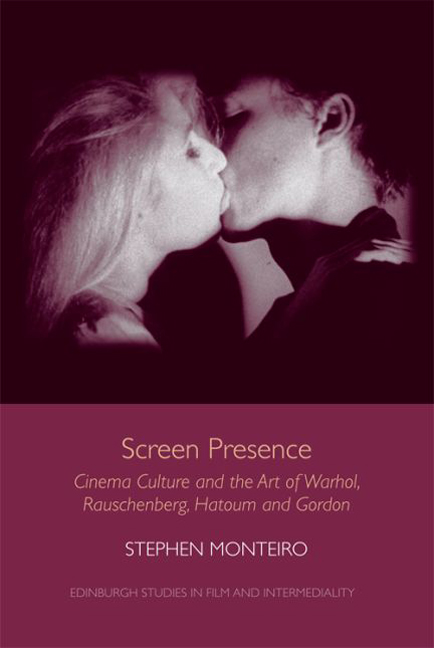Book contents
- Frontmatter
- Contents
- List of Figures
- Acknowledgements
- Introduction: Cinema's Grey Spaces
- 1 A Wider Audience: Robert Rauschenberg, the White Paintings and CinemaScope
- 2 The Screen Scene: Andy Warhol, the Factory and Home Movies
- 3 Private Dis-Pleasures: Mona Hatoum, Mediated Bodies and the Peep Show
- 4 A Monument in Ruins: Douglas Gordon, Screen Archaeology and the Drive-in
- Conclusion
- Index
Introduction: Cinema's Grey Spaces
Published online by Cambridge University Press: 15 September 2017
- Frontmatter
- Contents
- List of Figures
- Acknowledgements
- Introduction: Cinema's Grey Spaces
- 1 A Wider Audience: Robert Rauschenberg, the White Paintings and CinemaScope
- 2 The Screen Scene: Andy Warhol, the Factory and Home Movies
- 3 Private Dis-Pleasures: Mona Hatoum, Mediated Bodies and the Peep Show
- 4 A Monument in Ruins: Douglas Gordon, Screen Archaeology and the Drive-in
- Conclusion
- Index
Summary
Moving images inhabit the spaces of contemporary art. We regularly find them glowing on screens at exhibitions, fairs, festivals and performances. They form a part – sometimes a large part – of public and private collections around the world. As a result, screens and beams of light have become as common to the gallery experience as white walls and track lighting. Despite this ubiquity, however, there has not been adequate reckoning of the diverse historical and aesthetic origins of projected, moving-image art. ‘After years of being fixed onto celluloid, gripped by the teeth of the film projector, and confined to the single screen of the cinema auditorium, the moving image has escaped’, Catherine Fowler declares in her study of the projected image in the gallery. ‘No longer purely celluloid, no longer solely projected, present on multiple screens and in a variety of spaces, “cinema” … is everywhere’. Whether it be everywhere today, the historical evidence suggests cinema was already everywhere yesterday. Throughout its history, collective viewing of projected moving images has never been limited to the single screen of the theatre, but has proliferated in a variety of places, institutions and circumstances. This diversity of cinema culture (whether relying on film, magnetic tape or digital supports) has shaped art's appropriation of, and response to, projected moving images since the second half of the twentieth century. However, the intersection of these multiple historical and cultural vectors in projection-based contemporary art has been largely minimised or ignored by critics and historians.
This book attempts to remedy that error by demonstrating the influence of cinema's differing forms on the careers of four highly regarded artists. It asserts the dependence of Andy Warhol, Robert Rauschenberg, Mona Hatoum and Douglas Gordon on a broad range of moving-image practices as they employed the materials, mechanisms and aesthetics of several modalities for making and projecting images. The chapters that follow trace the impact of multiple, popular film and video cultures on artworks instantiating the moving image from the mid-1950s into the 2000s. They reflect the hypothesis that often marginalised non-theatrical forms, such as home movies and pornographic peep shows, or specialised commercial exhibition modes such as CinemaScope and the drive-in, represent variant examples of cinema that are fundamental to such art.
- Type
- Chapter
- Information
- Screen PresenceCinema Culture and the Art of Warhol, Rauschenberg, Hatoum and Gordon, pp. 1 - 18Publisher: Edinburgh University PressPrint publication year: 2016



